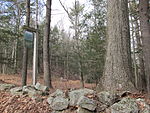Leadmine Wildlife Management Area

Leadmine Wildlife Management Area is a 640-acre (260 ha) wildlife conservation area located in Holland and Sturbridge, Massachusetts. The conservation area abuts the Tantiusques reservation and its satellite Crowd Site, owned by The Trustees of Reservations. It is managed by the Massachusetts Division of Fisheries and Wildlife. Hunting (in season), hiking, and other outdoor recreational pursuits are enjoyed on the property. The conservation area is named after the nearby colonial-era graphite mining industry at Tantiusques. Note that the Leadmine WMA pond depicted on this page may no longer exist in the same form (or even as a pond anymore) as in 2017 the dams were removed from the three adjacent ponds (Upper Pond, Middle Pond and Lower Pond) which were then linked in series by Hamant Brook.
Excerpt from the Wikipedia article Leadmine Wildlife Management Area (License: CC BY-SA 3.0, Authors, Images).Leadmine Wildlife Management Area
Williams Road,
Geographical coordinates (GPS) Address Nearby Places Show on map
Geographical coordinates (GPS)
| Latitude | Longitude |
|---|---|
| N 42.068944 ° | E -72.135028 ° |
Address
Leadmine Wildlife Management Area
Williams Road
01521
Massachusetts, United States
Open on Google Maps









